|
|
|
Sort Order |
|
|
|
Items / Page
|
|
|
|
|
|
|
| Srl | Item |
| 1 |
ID:
107704
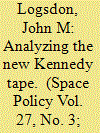

|
|
|
| 2 |
ID:
122526
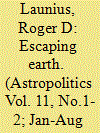

|
|
|
|
|
| Publication |
2013.
|
| Summary/Abstract |
What if we viewed the history of human spaceflight somewhat less through the lens of Cold War politics, which admittedly was central to the race to the Moon, but more as an expression of what might be called a religion of spaceflight? There seems to be a deeply religious quality to advocacy for the investment in and support for human space exploration, lending to the endeavor of a "higher purpose" that helps to explain both the generous nature of the actual investment and the ultimate unwillingness of Americans to eviscerate space budgets despite less than full support for space exploration. This article examines religious conceptions as a means of analyzing what might be termed a "space gospel." I lay out here the proposition that human spaceflight may be viewed as a religion with similar attributes to those present in mainstream religious denominations. This approach to exploring the history of human spaceflight offers a different and useful frame of understanding that broadens basic conceptions about this aspect of the human past.
|
|
|
|
|
|
|
|
|
|
|
|
|
|
|
|
| 3 |
ID:
148485


|
|
|
|
|
| Summary/Abstract |
Recent research has highlighted the potential of lunar resources as an important element of space exploration but their viability has not been demonstrated. Establishing whether or not they can be considered in future plans is a multidisciplinary effort, requiring scientific expertise and delivering scientific results.
To this end various space agencies and private entities are looking to lunar resources, extracted and processed in situ, as a potentially game changing element in future space architectures, with the potential to increase scale and reduce cost. However, before any decisions can be made on the inclusion of resources in exploration roadmaps or future scenarios some big questions need to be answered about the viability of different resource deposits and the processes for extraction and utilisation. The missions and measurements that will be required to answer these questions, and which are being prepared by agencies and others, can only be performed through the engagement and support of the science community.
In answering questions about resources, data and knowledge will be generated that is of fundamental scientific importance. In supporting resource prospecting missions the science community will de facto generate new scientific knowledge. Science enables exploration and exploration enables science.
|
|
|
|
|
|
|
|
|
|
|
|
|
|
|
|
| 4 |
ID:
137414
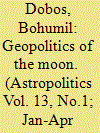

|
|
|
|
|
| Summary/Abstract |
The article deals with the reasons why European countries should care about lunar settlement. First, the article focuses on the issue of geopolitics of the Moon and the importance of its natural resources—both energy and non-energy—and the relevance of lunar poles. The article then discusses European Union (EU) and European Space Agency (ESA) space activities. Next, there are basic strategic considerations EU/ESA countries should follow in utilizing outer space. From a terrestrial point of view, it is mainly the issue of energy independence and, from outer space, it is the possibility of denial of access to outer space. The article concludes with the acknowledgment of a growing interest in lunar colonization around the world and that Europeans should become more assertive in their lunar ambitions, including lunar development projects, for economic and strategic reasons.
|
|
|
|
|
|
|
|
|
|
|
|
|
|
|
|
| 5 |
ID:
178949
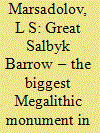

|
|
|
| 6 |
ID:
042450
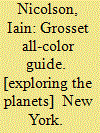

|
|
|
|
|
| Publication |
New York, Grosset & Dunlap, 1971.
|
| Description |
159p.Hbk
|
| Series |
The, Grosset all-color guide series
|
| Standard Number |
0448008688
|
|
|
|
|
|
|
|
|
|
|
|
Copies: C:1/I:0,R:0,Q:0
Circulation
| Accession# | Call# | Current Location | Status | Policy | Location |
| 008763 | 621.38238/NIC 008763 | Main | On Shelf | General | |
|
|
|
|
| 7 |
ID:
099622
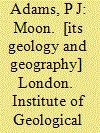

|
|
|
|
|
| Publication |
London, Institute of Geological Science, 1968.
|
| Description |
36p.
|
|
|
|
|
|
|
|
|
|
|
|
Copies: C:1/I:0,R:0,Q:0
Circulation
| Accession# | Call# | Current Location | Status | Policy | Location |
| 002532 | 523.3/ADA 002532 | Main | On Shelf | General | |
|
|
|
|
| 8 |
ID:
142554
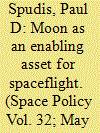

|
|
|
| 9 |
ID:
107701


|
|
|
|
|
| Publication |
2011.
|
| Summary/Abstract |
This paper analyses potential future collaborative space exploration architectures in terms of 1) the technical capabilities of contributing partners; and 2) the constraints imposed by internal and international politics. We find that when international partners are considered endogenously, the argument for a "flexible path" approach is weakened substantially. This is because international contributions can make "Moon first" economically feasible; and characteristics of proposed "flexible path" approaches may preclude international involvement because of the disproportionate risk that those contributions inherently bear. This could have serious implications for future collaborations. We also note that while there are multiple feasible collaborative architectures, there is currently substantial overlap among the potential niche contributions identified by the international partners.
|
|
|
|
|
|
|
|
|
|
|
|
|
|
|
|
| 10 |
ID:
169345
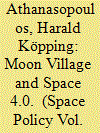

|
|
|
|
|
| Summary/Abstract |
This article discusses the Moon Village concept within the context of the increasing momentum to return human beings to the surface of the Moon. The article follows a dual objective. Firstly, the Moon Village is probably the most misunderstood among the plethora of ideas to explore the Moon scientifically and commercially. The article is therefore intended to explore what the Moon Village actually is. Secondly, the article explores the strengths and weaknesses of the Moon Village. The article is divided into three sections. The first section reviews the current Moon projects of public and private space actors, including the United States, Russia, China, SpaceX and Blue Origin. It sets the scene for the argument that the Moon Village has entered global discourse on space within a positive political environment. The second section discusses the premises of ESA chief Jan Wörner’s Moon Village concept, putting forward that the Moon Village is intended as an open concept rather than as a concrete plan. It is a process rather than a project and it is meant to initiate a global conversation on humanity’s future on the Moon. As such, the world café is an appropriate metaphor to illustrate the idea behind the Moon Village. In the third and final section a SWAT/PEST analysis is conducted to assess the feasibility of the Moon Village, highlighting that one of the major opportunities of the project is to promote international cooperation. The article concludes by supporting the institutionalist hypothesis that the Moon Village is arguably a translation of the ESA system to the global level, as participation is voluntary and as it builds on the strengths of each cooperation partner. As such, the Moon Village in indeed a new way of doing space on the global level.
|
|
|
|
|
|
|
|
|
|
|
|
|
|
|
|
| 11 |
ID:
147519
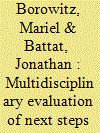

|
|
|
|
|
| Summary/Abstract |
There is a growing consensus among stakeholders around the world that the long-term objective of human space exploration is the long-duration presence of humans on the surface of Mars. However, the key question concerns the choice of near-term missions that will bridge current human spaceflight activities in low Earth orbit (LEO) and eventual Mars exploration. This paper contributes to this debate by identifying the scope of possible near-term missions, arguing that there are only four realistic proposals for initial human exploration beyond low Earth orbit: a cis-lunar habitat, asteroid redirect, Mars flyby, and a short lunar surface sortie. The paper then evaluates these missions across five criteria: 1) technical/economic feasibility, 2) contribution to the eventual goal of exploring Mars, 3) potential for international cooperation, 4) global readiness for the mission, and 5) political feasibility to establish a clear assessment of the pros and cons of each of these four missions. While recognizing that any one of these missions represents a feasible option for future human space exploration, we recommend that the international community pursue development of a cis-lunar habitat as its immediate goal. This mission maximizes development of technology necessary for Mars exploration, provides significant opportunities for meaningful international participation, and could be achieved on a reasonable schedule with current budgets. Both the asteroid redirect mission and lunar exploration plans have the potential to benefit from the development of a cis-lunar habitat and could be retained as intermediate or parallel missions, as resources allow.
|
|
|
|
|
|
|
|
|
|
|
|
|
|
|
|
| 12 |
ID:
115851


|
|
|
| 13 |
ID:
157164


|
|
|
|
|
| Summary/Abstract |
The Outer Space Treaty makes it clear that the Moon is the ‘province of all mankind’, with the latter ordinarily understood to exclude state or private appropriation of any portion of its surface. However, there are indeterminacies in the Treaty and in space law generally over the issue of appropriation. These indeterminacies might permit a close approximation to a property claim or some manner of ‘quasi-property’. The recently revealed highly inhomogeneous distribution of lunar resources changes the context of these issues. We illustrate this altered situation by considering the Peaks of Eternal Light. They occupy about one square kilometer of the lunar surface. We consider a thought experiment in which a Solar telescope is placed on one of the Peaks of Eternal Light at the lunar South pole for scientific research. Its operation would require non-disturbance, and hence that the Peak remain unvisited by others, effectively establishing a claim of protective exclusion and de facto appropriation. Such a telescope would be relatively easy to emplace with today’s technology and so poses a near-term property issue on the Moon. While effective appropriation of a Peak might proceed without raising some of the familiar problems associated with commercial development (especially lunar mining), the possibility of such appropriation nonetheless raises some significant issues concerning justice and the safeguarding of scientific practice on the lunar surface. We consider this issue from scientific, technical, ethical and policy viewpoints.
|
|
|
|
|
|
|
|
|
|
|
|
|
|
|
|
| 14 |
ID:
142577


|
|
|
|
|
| Summary/Abstract |
The paper offers a proposition in which the notion of the 'ownership' of outer space is substituted for that of 'authorship'. The notion of authorship draws attention to the processes of critical thinking, re-contextualization and resistances to space technology that take place in social domains where no clear role exists either as audience or user of space technology. The proposition responds in part to interventions made by artists in recent years into the workplaces of space technologists and, incrementally, into the imaginaries that inform the kinds of activities that happen in space. Artistic processes expose the reception of space technology at an intimate scale where the agencies of the viewer to observe, absorb and rethink converge with the shaping of space technology via state mediation and space agency imperatives. The constituency of collective authorship to which space technologies are subject is revealed in unexpected ways through artistic intervention that suggests a reappraisal of some of the terms of reference guiding space policy.
|
|
|
|
|
|
|
|
|
|
|
|
|
|
|
|
| 15 |
ID:
179181
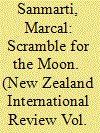

|
|
|
|
|
| Summary/Abstract |
NASA's plan to return to the Moon is probably familiar to most. Former US President Donald Trump set a very ambitious goal: to have American women and men stepping on the Moon by 2024. Many consider that an unrealistically short timescale. But international competition to go back to the Moon is fierce. It is not just the United States and China competing to send humans there again. Many other countries have plans, not just giants like Russia, India or the European Union. Japan, Israel, the United Arab Emirates, Canada, the United Kingdom, Turkey and even tiny Luxemburg also have plans.
|
|
|
|
|
|
|
|
|
|
|
|
|
|
|
|
| 16 |
ID:
142552
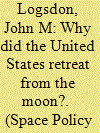

|
|
|
|
|
| Summary/Abstract |
On July 20, 1969, Neil Armstrong and Buzz Aldrin took the first human steps on a celestial body other than Earth. Just over two weeks later, on August 4, NASA presented to a committee charged with making recommendations on the U.S. post-Apollo space program a bold plan of continued lunar and Martian exploration. Over the next six months, that plan was decisively rejected by the administration of President Richard M. Nixon. In 1970, NASA canceled the final two Apollo missions to the Moon, and on January 5, 1972, President Nixon announced approval of the space shuttle program. Focusing the U.S. space program on operating the space shuttle and building a space station has kept the United States human space flight program confined to low Earth orbit for over four decades. There are lessons to be learned from the post-Apollo decisions in the United States for today's attempts to gain political support for a renewed and sustainable program of human exploration of the Moon, Mars, and other solar system destinations. This paper, drawing on in-depth research on the events of the 1969–1972 period in U.S. space policy, will discuss those lessons.
|
|
|
|
|
|
|
|
|
|
|
|
|
|
|
|
|
|
|
|
|